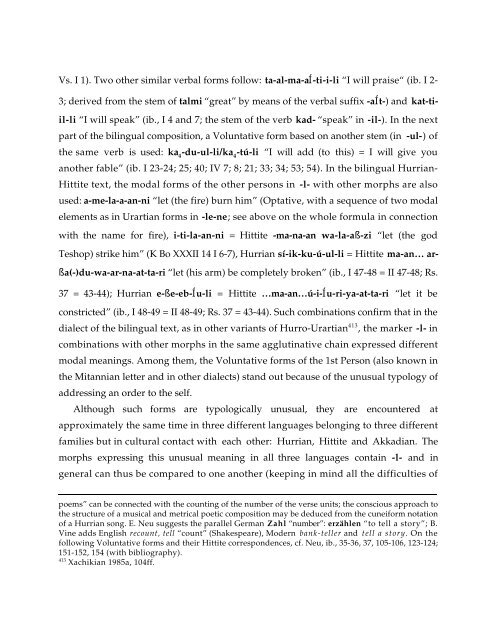Comparative Notes on Hurro-Urartian, Northern Caucasian
Comparative Notes on Hurro-Urartian, Northern Caucasian
Comparative Notes on Hurro-Urartian, Northern Caucasian
Create successful ePaper yourself
Turn your PDF publications into a flip-book with our unique Google optimized e-Paper software.
Vs. I 1). Two other similar verbal forms follow: ta-al-ma-aÍ-ti-i-li “I will praise“ (ib. I 2-<br />
3; derived from the stem of talmi “great” by means of the verbal suffix -aÍt-) and kat-ti-<br />
il-li “I will speak” (ib., I 4 and 7; the stem of the verb kad- “speak” in -il-). In the next<br />
part of the bilingual compositi<strong>on</strong>, a Voluntative form based <strong>on</strong> another stem (in -ul-) of<br />
the same verb is used: ka 4 -du-ul-li/ka 4 -tú-li “I will add (to this) = I will give you<br />
another fable” (ib. I 23-24; 25; 40; IV 7; 8; 21; 33; 34; 53; 54). In the bilingual Hurrian-<br />
Hittite text, the modal forms of the other pers<strong>on</strong>s in -l- with other morphs are also<br />
used: a-me-la-a-an-ni “let (the fire) burn him” (Optative, with a sequence of two modal<br />
elements as in <strong>Urartian</strong> forms in -le-ne; see above <strong>on</strong> the whole formula in c<strong>on</strong>necti<strong>on</strong><br />
with the name for fire), i-ti-la-an-ni = Hittite -ma-na-an wa-la-aß-zi “let (the god<br />
Teshop) strike him” (K Bo XXXII 14 I 6-7), Hurrian sí-ik-ku-ú-ul-li = Hittite ma-an… ar-<br />
ßa(-)du-wa-ar-na-at-ta-ri “let (his arm) be completely broken” (ib., I 47-48 = II 47-48; Rs.<br />
37 = 43-44); Hurrian e-ße-eb-Íu-li = Hittite …ma-an…ú-i-Íu-ri-ya-at-ta-ri “let it be<br />
c<strong>on</strong>stricted” (ib., I 48-49 = II 48-49; Rs. 37 = 43-44). Such combinati<strong>on</strong>s c<strong>on</strong>firm that in the<br />
dialect of the bilingual text, as in other variants of <strong>Hurro</strong>-<strong>Urartian</strong> 413 , the marker -l- in<br />
combinati<strong>on</strong>s with other morphs in the same agglutinative chain expressed different<br />
modal meanings. Am<strong>on</strong>g them, the Voluntative forms of the 1st Pers<strong>on</strong> (also known in<br />
the Mitannian letter and in other dialects) stand out because of the unusual typology of<br />
addressing an order to the self.<br />
Although such forms are typologically unusual, they are encountered at<br />
approximately the same time in three different languages bel<strong>on</strong>ging to three different<br />
families but in cultural c<strong>on</strong>tact with each other: Hurrian, Hittite and Akkadian. The<br />
morphs expressing this unusual meaning in all three languages c<strong>on</strong>tain -l- and in<br />
general can thus be compared to <strong>on</strong>e another (keeping in mind all the difficulties of<br />
poems” can be c<strong>on</strong>nected with the counting of the number of the verse units; the c<strong>on</strong>scious approach to<br />
the structure of a musical and metrical poetic compositi<strong>on</strong> may be deduced from the cuneiform notati<strong>on</strong><br />
of a Hurrian s<strong>on</strong>g. E. Neu suggests the parallel German Zahl “number”: erzählen “to tell a story”; B.<br />
Vine adds English recount, tell “count” (Shakespeare), Modern bank-teller and tell a story. On the<br />
following Voluntative forms and their Hittite corresp<strong>on</strong>dences, cf. Neu, ib., 35-36, 37, 105-106, 123-124;<br />
151-152, 154 (with bibliography).<br />
413 Xachikian 1985a, 104ff.





